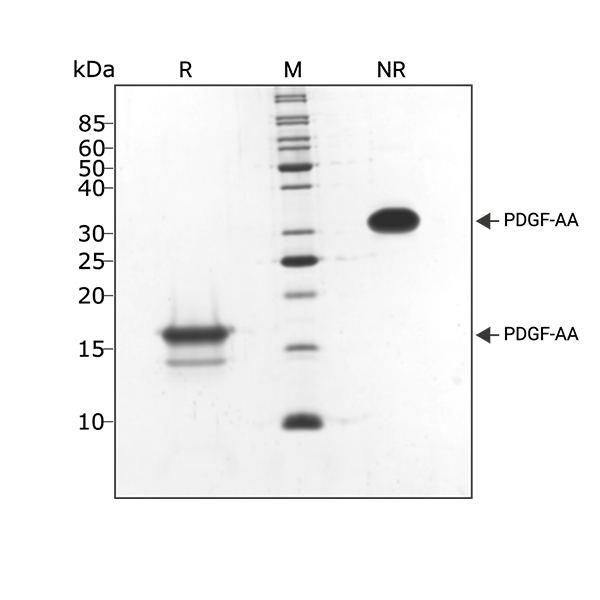 Recombinant human PDGF-AA protein (Qk043)
Recombinant human PDGF-AA protein (Qk043)Recombinant human PDGF-AA protein (Qk043)
Price range: £230.00 through £2,900.00
Human PDGF-AA (platelet derived growth factor AA) protein is a homodimer of PDGF-A peptide chains. PDGF-AA is commonly used to differentiate human pluripotent stem cell (hPSC)-derived neural progenitor cells into oligodendrocyte precursor cells.
Qkine human PDGF-AA is a high purity 29 kDa disulfide–linked bioactive dimeric protein, animal origin-free (AOF) and carrier protein-free.
In stock
Orders are typically shipped same or next day (except Friday).
Easy world-wide ordering, direct or through our distributors.
Price range: £230.00 through £2,900.00
Buy online with secure credit card or purchase order. For any questions, please email orders@qkine.com
Summary:
- High purity human PDGF-AA protein (Uniprot: P04085)
- 29 kDa
>98%, by SDS-PAGE quantitative densitometry
Expressed in E. coli
Animal origin-free (AOF) and carrier protein-free
Manufactured in our Cambridge, UK laboratories
Lyophilized from acetonitrile, TFA
- Resuspend in sterile-filtered water at >50 µg/ml, add carrier protein if desired, prepare single use aliquots and store frozen at -20 °C (short-term) or -80 °C (long-term).
Featured applications:
Differentiation of neural progenitor cells into oligodendrocyte precursor cells

PDGF-AA activity was measured using a NFAT-responsive luciferase assay in HEK293 cells co-transfected with PDGFAR. Cells were treated in triplicate with a serial dilution of PDGF-AA for 6 hours. Firefly luciferase activity was measured and normalized to the control Renilla luciferase activity. Data from Qk043 lot #104383. EC50 = 109 ng/ml (3.8 nM).
PDGF-AA migrates as a single band at ~30 kDa in non-reducing (NR) conditions and ~15 kDa upon reduction (R). The additional faint lower molecular weight band in the reduced condition (R) is due to the harsh treatment required to fully reduce the disulfide linked dimer. Purified recombinant protein (3 µg) was resolved using 15% w/v SDS-PAGE in reduced (+β-mercaptothanol, R) and non-reduced (NR) conditions and stained with Coomassie Brilliant Blue R250. Data from PDGF-AA Qk043 batch #104307.

Further quality assays
Mass spectrometry: single species with expected mass
Recovery from stock vial: >95%
Endotoxin: <0.005 EU/μg protein (below level of detection)
We are a company founded and run by scientists to provide a service and support innovation in stem cell biology and regenerative medicine. All our products are exceptionally high purity, with complete characterisation and bioactivity analysis on every lot.
Protein background
Platelet derived growth factor (PDGF) is part of the PDGF/VEGR family. As the name suggests it is produced by platelets, and by several other cell types including endothelial cells, fibroblasts, vascular smooth muscle cells, osteoblasts, glia and neurons [1]. In platelets, PDGF is stored in α-granules, and released in response to platelet activation, leading to stimulation of epithelial cells.
PDGFs are dimers of PDGF-A, -B, -C or -D polypeptide chains, arranged in homodimers (eg PDGF-AA and PDGF-BB) or heterodimers (eg PDGF-AB). There are two receptors for PDGFs, PDGFR-α and PDGFR-β. PDGFR-α is a receptor for all PDGF dimers apart from PDGF-DD, while PDGFR-β is a receptor for PDGF-BB and PDGF-DD [2]. Activation of these receptors by PDGF leads to activation of downstream signalling pathways including PI3K, MAPK and STAT3 pathways [3]. PDGF plays an important role in embryonic development [4], cell proliferation, cell migration and angiogenesis. PDGF is a potent mitogen for cells of mesenchymal origin such as fibroblasts, glial cells and vascular smooth muscle cells.
PDGF-AA is commonly used to differentiate human pluripotent stem cell (hPSC)-derived neural progenitor cells into oligodendrocyte precursor cells [5].
Our products are for research use only and not for diagnostic or therapeutic use. Products are not for resale.
For use in manufacturing of cellular or gene therapy products. Not intended for in vivo applications.

Receive an Amazon gift voucher when you leave us a review.
£25, $30 or €30 for reviews with an image and £10, $15 or €15 for reviews without an image
